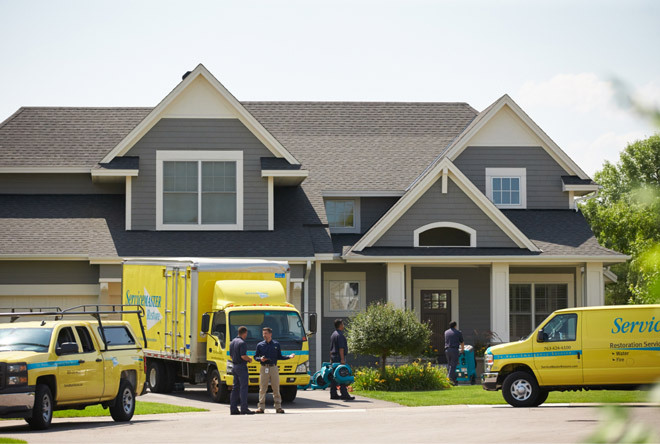Water Damage Restoration
Frequently Asked Questions
-
How long will it take my property to dry?
-
Drying time is determined by a combination of factors, including:
- The location, duration, and source of water damage
- The types of building materials
- The weather conditions
- How quickly emergency services begin
Through consistent monitoring and evaluation of the drying process, we can determine when the drying is complete. Although your carpet may feel dry to the touch, padding and subfloors may still be affected by water.
-
How do I know when my property is completely dry?
-
Proper testing with our specialized equipment is the proper way to determine if your property are completely dry.
-
Will turning up the heat help dry things out?
-
Not necessarily. We will adjust the temperature to its optimum setting for the proper drying conditions. Please do avoid changing the setting, or shutting off the HVAC system; doing so will extend the time it take for your property to dry completely.
-
What about my wet furniture?
-
The scale of damage done will determine if your furniture can be restored. Your furniture must be dried before damage can be adequately assessed. If it can be properly restored, our team will work on getting it back to pre-loss condition.
Unsalvageable furniture will be documented for you, and if any items need to be discarded, a customer release form will need to be signed.
-
Do I need to move out of my property during the drying process?
-
Air movers and dehumidifiers will create noise and make your property drafty for a few days. It is important that the equipment remains on to properly dry the property. If the noise is disruptive to you, you may want to consider an alternate place to stay till drying is completed.
-
Does everything need to be moved out during restoration?
We will need to assess the area with water damage to see if it is required. If items need to be moved out, we will let you know in advance. We offer content packing and storage if you need a place to store contents of your building till repairs are completed.
-
My ceilings are wet. What needs to be done?
-
It can mean a few things like pipe leak, roof leak, or leaking bathtub or shower, but we recommend giving us a call if you notice wet spots on your ceilings. Our team will evaluate moisture content, determine the severity of the damage, and may have to remove some of your ceiling for ventilation.
-
Can I walk on the area during the drying process?
-
It is strongly suggested that you keep the traffic to a minimum. Wearing shoes is recommended for your safety.
-
Can my carpet be restored or will it have to be replaced?
-
A few reasons your carpet may not be salvageable:
- Delamination (occurs when the backing separates from the carpet fiber)
- Permanent stains
- Loss of adhesion (may be caused by prolonged exposure to water or age of the carpet)
- Carpet covers wood flooring (to salvage the wood flooring)
- Sewage contamination
-
The wood floors are wet and buckling. Will they need to be replaced?
-
Wood flooring must be evaluated during the drying process. We make use of specialized drying systems and dehumidifiers that allow us to dry wood floors efficiently and resume their original shape. We will try to restore the wood flooring back to pre loss condition if possible, and we will also inform you if replacing wood floors is necessary.
-
Why does my specialty floor need to be removed?
-
Nonporous flooring can trap water and prevent it from drying properly.
-
Why did the technician leave wet carpet on my stairs?
-
Carpet on the stairs is generally not removed for safety reasons. Exposed tack strips or staples, especially on steps, is dangerous. However, there are situations where removing carpet from stairs is necessary to prevent damage to hardwood steps or in the case of sewage contamination. Removing tack strips is not advised, as this may damage the hardwood or the subfloor. Extreme caution must be used whenever the tack strip is exposed or when the carpeted stairs are damp. If carpet left on the stairs is unsalvageable, it will be removed when new carpet is installed.
-
What will you do with my area rugs?
-
Rugs are transported to our warehouse for restoration. They need to be dried carefully to minimize bleeding of colors and discoloration. Your rugs will be dried, cleaned, and returned.
-
Why are air movers and dehumidifiers used?
-
When water damage has occurred, water can be absorbed into the drywall, baseboards, subflooring, and more. Drying these surfaces requires specialized machines that deliver air at high speeds to accelerate the release of absorbed water into the air.
Dehumidifiers are necessary for removing excess moisture to help protect property and create conditions for efficient drying. Please do not turn off or move drying equipment without first calling ServiceMaster Restore.
-
What about sewage contamination?
-
While hard-surfaces can be cleaned and sanitized, affected items that cannot be sanitized require disposal. Porous materials with sewage contamination on drywall, ceiling tiles, insulation, particleboard, paneling, etc., should be removed during the emergency service visit.


